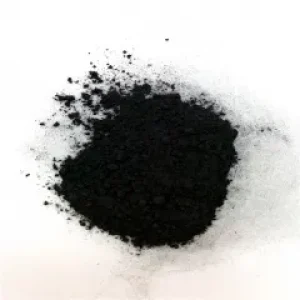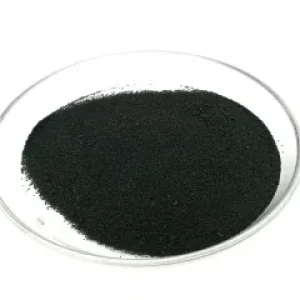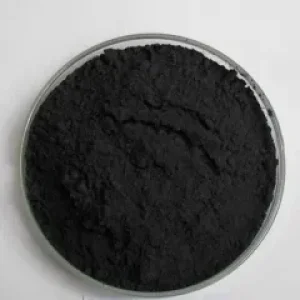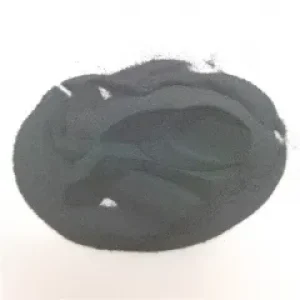Overview of Titanium Carbide Powder
The titanium carbide chemical formula is TiC, and the molecular weight is 59.89. Gray metal-like face-centered cubic lattice solid. The titanium carbide melting point is 3140±90°C. The titanium carbide boiling point is 4820°C, and the relative density is 4.93. The hardness is greater than 9. Insoluble in water, soluble in nitric acid, and aqua regia. TiC compound is stable to air when it is lower than 800℃, it is corrupted by air when it is higher than 2000℃, and it can react with pure O2 when it is 1150℃.
Titanium carbide TiC is a hard (Mohs 9–9.5) refractory ceramic material, similar to tungsten carbide. It resembles a black powder with a sodium chloride (face-centered cubic) crystal structure. Titanium carbide has an elastic modulus of about 400 GPa and a shear modulus of 188 GPa.
Titanium carbide appears in nature as a very rare mineral, Rhodochrosite (Ti, V, Fe) C. It was discovered in 1984 on the Ala Mountain in the Chagar region of the Soviet Union (modern Kyrgyzstan) near the border of Uzbekistan. Found in nature, its crystals range from 0.1 to 0.3 mm.
Properties of Titanium Carbide TiC Powder
The chemical formula TiC has a molecular weight of 59.89. Gray metallic lustrous crystalline solid. The melting point is 3140℃, the boiling point is 4820℃, and the relative density is 4.93. Hardness 9-10. Insoluble in water, soluble in nitric acid, and aqua regia. It is stable to air when lower than 800℃, eroded by air when higher than 2000℃, and can react with pure oxygen at 1150℃. Used for making cemented carbide, as electrode and abrasive of arc lamp.
Technical Parameter of Titanium Carbide TiC Powder
|
Ti+C |
C | S | Si | O | Free Carbon |
| 99.2 | 19.5 | 0.02 | 0.01 | 0.4 |
0.2 |
Production Method of Titanium Carbide TiC Powder
There are many ways to synthesize titanium carbide; the most common are the following:
1. Carbothermic reduction method
Use carbon black to reduce TiO2; the reaction temperature range is 1700-2100℃, and the chemical reaction formula is TiO2(s)+3C(s)=TiC(S)+2CO(g).
2. Direct carbonization
Ti powder and carbon powder react to generate TiC. The chemical reaction formula is Ti(s)+C(s)=TiC. Because it is difficult to prepare sub-micron metal Ti powder, the application of this method is limited. The above reaction takes 5-20 hours to complete, and the reaction process is difficult to control. The reactants agglomerate seriously, and further grinding processing is required to prepare fine particles. Granular TiC powder. To obtain a purer product, it is necessary to chemically purify the fine powder after ball milling.
3. Chemical vapor deposition
The synthesis method utilizes the reaction between TiCl4, H2, and C. The reactant reacts with the hot tungsten or carbon monofilament, and TiC crystals grow directly on the monofilament. The TiC powder synthesized by this method has strict limits on its output and sometimes even its quality. In addition, due to TiCl4 and the product, The HCl contained in it is strongly corrosive, so be careful when synthesizing it.
4. Sol-gel method
A method for preparing small particle-size products by thoroughly mixing and dispersing materials employing a solution. It has the advantages of good chemical uniformity, small powder particle size and narrow distribution, and low heat treatment temperature. Still, the synthesis process is complex, and the drying shrinkage is large.
5. Microwave method
Take nano TiO2 and carbon black as raw materials, use the principle of the carbothermal reduction reaction, and use microwave energy to heat the material. It uses the dielectric loss of the material in the high-frequency electric field to convert microwave energy into heat energy so that nano-TiO2 and carbon are synthesized into TiC.
6. Blast impact method
The titanium dioxide and carbon powder are mixed in proportion and pressed into a cylinder of Φ10mm×5mm to prepare the precursor. The density is 1.5g/cm3, and the laboratory is put into a metal-constrained outer cylinder. Put it into a self-made airtight explosion container for the experiment, and collect the detonation ash after the explosion shock wave. After preliminary sieving, large impurities such as iron filings are removed, and black powder is obtained. The black powder becomes brown after being soaked in aqua regia for 24 hours, and finally put into a muffle furnace and calcined at 400°C for 400 minutes to obtain a silver-gray powder.
7. High-frequency induction carbothermic reduction method
Weigh and mix the pigment-grade titanium dioxide powder and charcoal powder at a molar ratio of 1:3 and 1:4, add them into a ball mill tank, and mill them on a planetary ball mill for 6-10 hours at a speed of 300-400r/min and then mill the material. Press the tablet press to form a block of 2cm×2cm~2cm×4cm, and finally, put the material into the graphite crucible and put it into the high-frequency induction heating equipment, argon gas as a protective atmosphere, and gradually adjust the current of the high-frequency induction equipment to 500A causes the material to undergo a carbothermal reduction reaction, and keep it for 20 minutes. After the heat preservation, the reduced product is naturally cooled to room temperature under an argon atmosphere. The reduced product is removed, and ultra-fine titanium carbide powder is obtained after grinding and crushing.
Application of Titanium Carbide TiC
The most common application of titanium carbide is cemented carbide, also used as an electrode and abrasive for arc lamps.
1. Titanium carbide powder, used for high-temperature thermal spraying materials, welding materials, hard film materials, military aviation materials, hard alloys, and cermets.
2. Titanium carbide is used as an additive in thermistor production to improve wear resistance.
3. Titanium carbide powder has a NaCl-type cubic crystal structure, and 6% to 30% TiC is added to the WC-Co cemented carbide to form a TiC-WC solid solution with WC, which can significantly improve the red heat and the wear resistance of the alloy.
4. Titanium carbide has anti-oxidation and anti-corrosion properties and is more suitable for processing steel than WC-Co cemented carbide.
5. Titanium carbide can also use alloys such as Ni-Mo as a binder to form tungsten-free cemented carbide, increasing the turning speed and the accuracy and smoothness of the workpiece.
6. Titanium carbide is used to prepare cermets, usually used for steel processing with high cutting speeds.
7. Titanium carbide is a wear-resistant surface coating on metal parts such as knife heads and watch mechanisms.
8. Titanium carbide coating: TiC is also used as a thermal insulation coating for re-entry of spacecraft atmosphere.
Storage Condition of Titanium Carbide TiC Powder
Titanium Carbide TiC Powder should be sealed in vacuum and stored in cool and dry room and it should not be exposure to air. In addition, the product should be avoided under stress.
FAQ
Q1: What are the physical properties of titanium carbide?
Answer: The melting point of titanium carbide is approximately 3140±90℃, and the boiling point is 4820℃. Its relative density is 4.93, its hardness is greater than 9, and it is insoluble in water but soluble in nitric acid and aqua regia.
Q2: What are the chemical properties of titanium carbide?
Answer: Titanium carbide is stable to air at lower temperatures, but will be corroded by air above a certain temperature (such as 2000°C). In the air, the surface of titanium carbide will react with oxygen to trigger a surface oxidation reaction and convert it into titanium dioxide.
Q3: What safety issues should we pay attention to when using titanium carbide?
Answer: When handling titanium carbide, you must wear necessary protective equipment, such as protective glasses, gloves and chemical protective clothing, to prevent titanium carbide powder from entering the human body. At the same time, it is necessary to operate in a well-ventilated area and ensure that the operating environment is dry and free of flammable factors such as open flames.
Q4: What effect does the oxidation of titanium carbide have on its performance?
Answer: The oxidation of titanium carbide will cause defects on the material surface and reduce its service life. Oxides can coat the surface of a material, affecting its appearance and optical properties. Excessive oxidation can also affect the physical and mechanical properties of materials, such as strength, hardness, etc.
Q5: What factors affect the price of titanium carbide?
Answer: The price of titanium carbide is affected by many factors such as raw material cost, production process, market demand and supply relationship, and international economic situation. When market demand increases or supply decreases, the price of titanium carbide may increase; conversely, the price may decrease.








